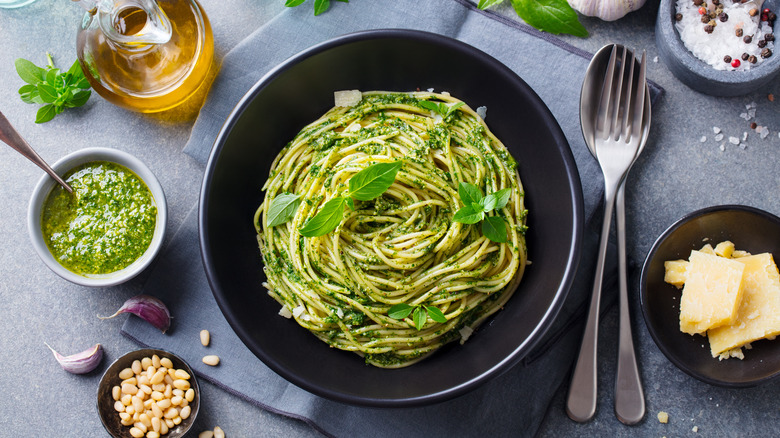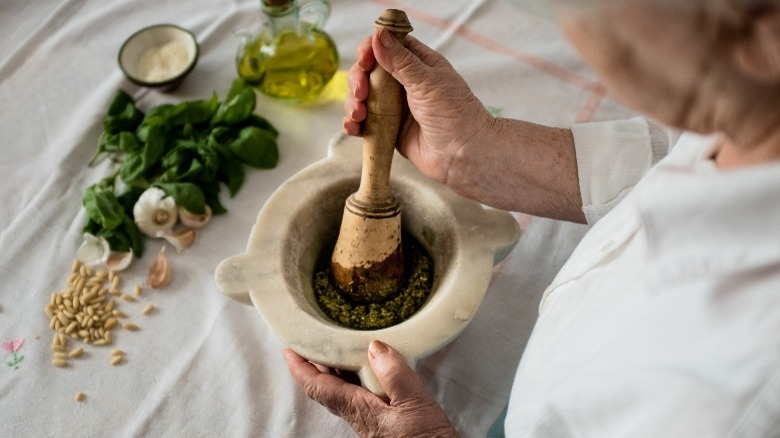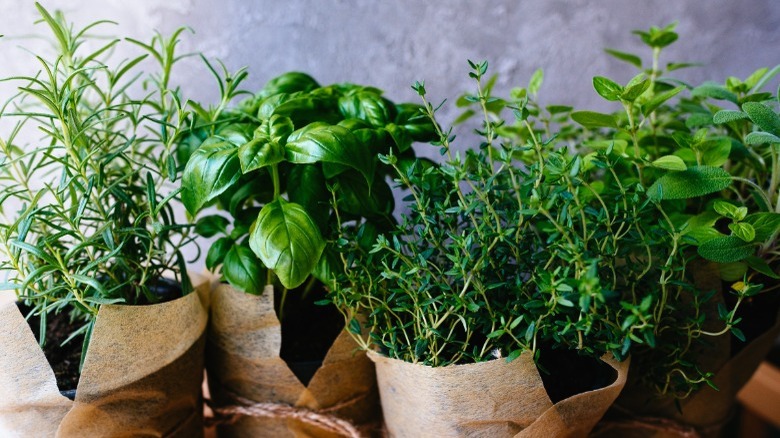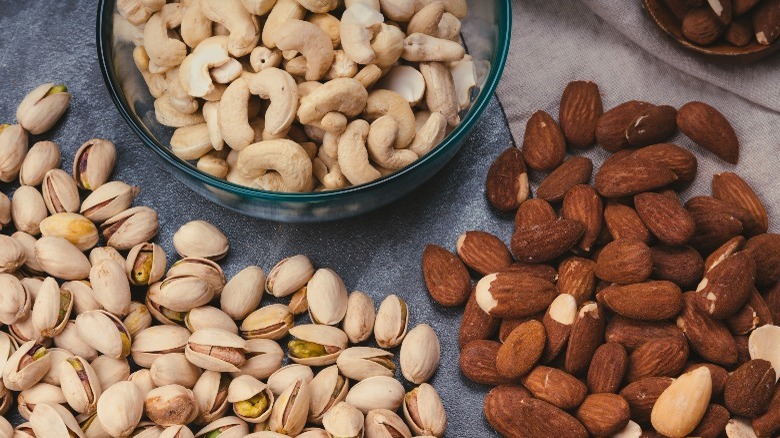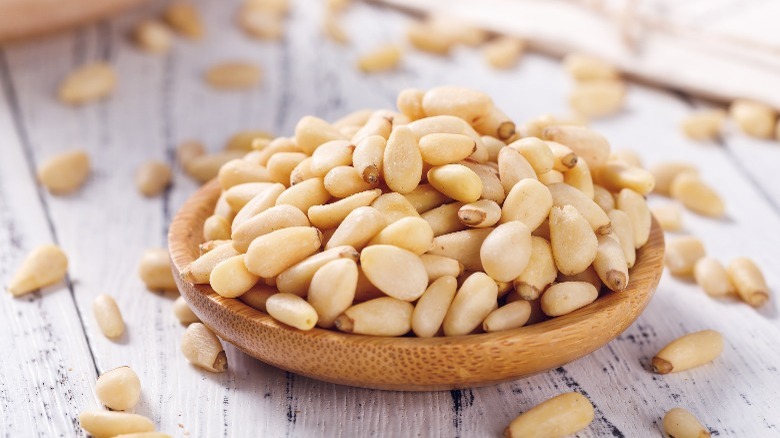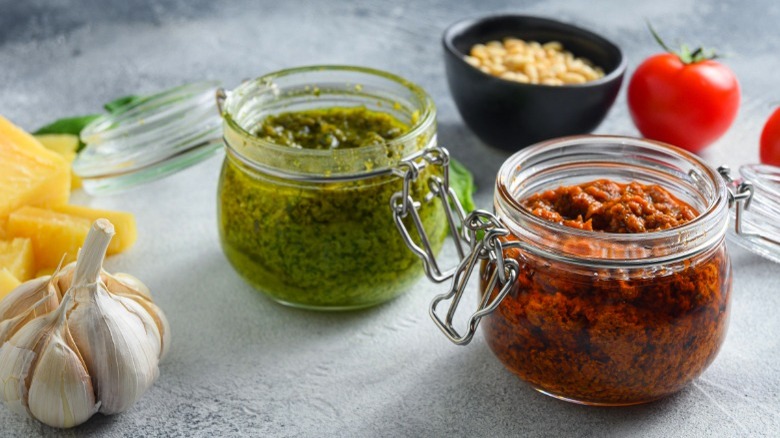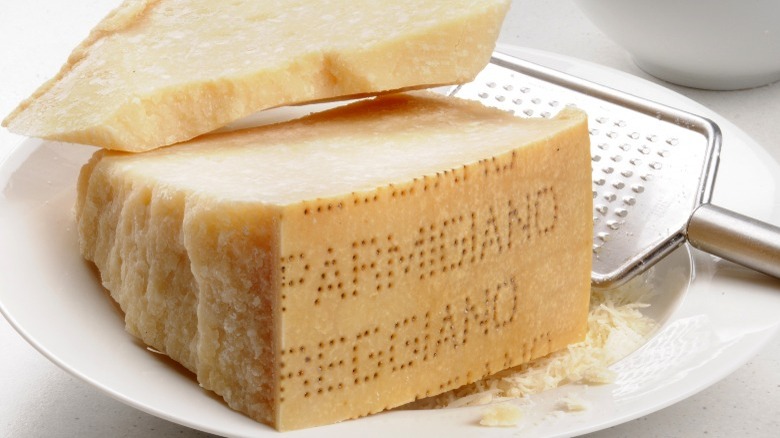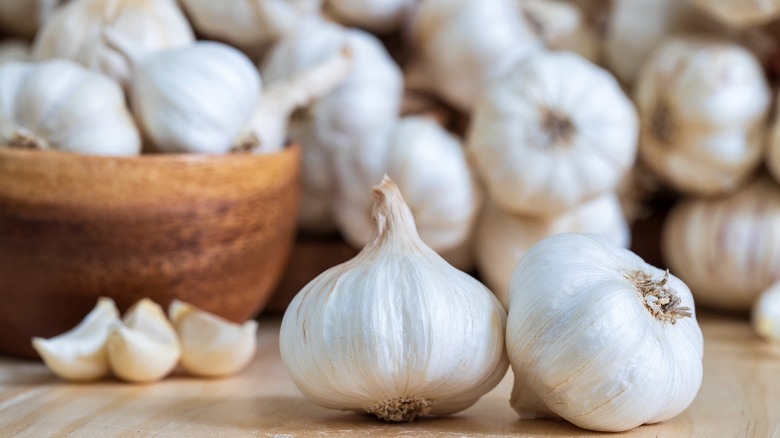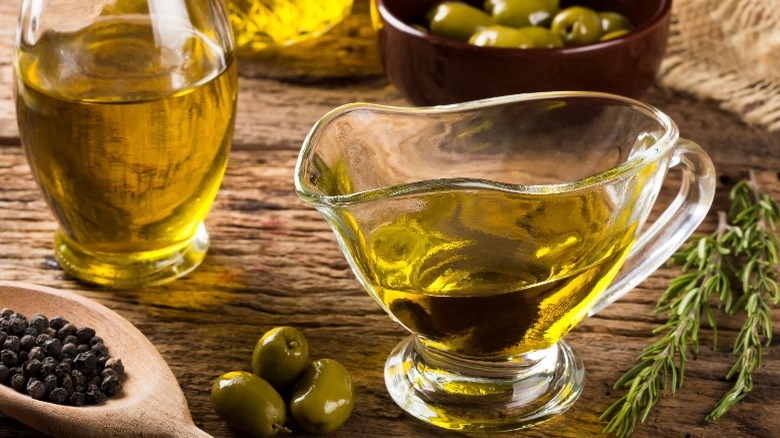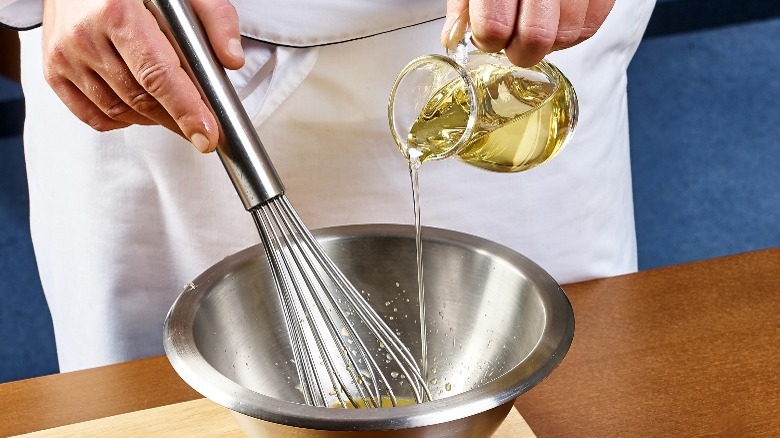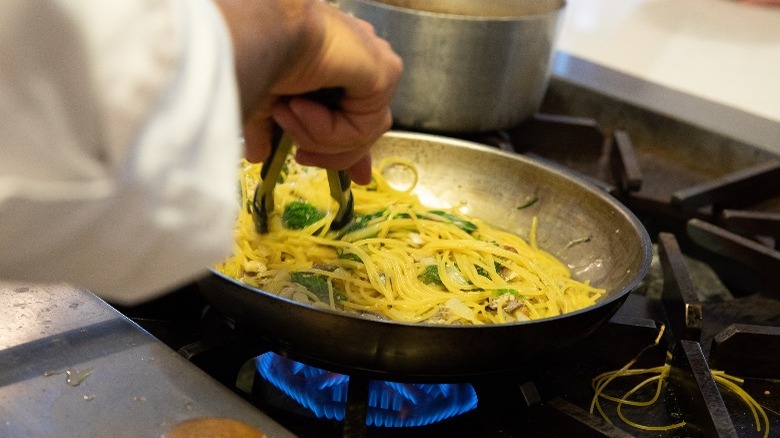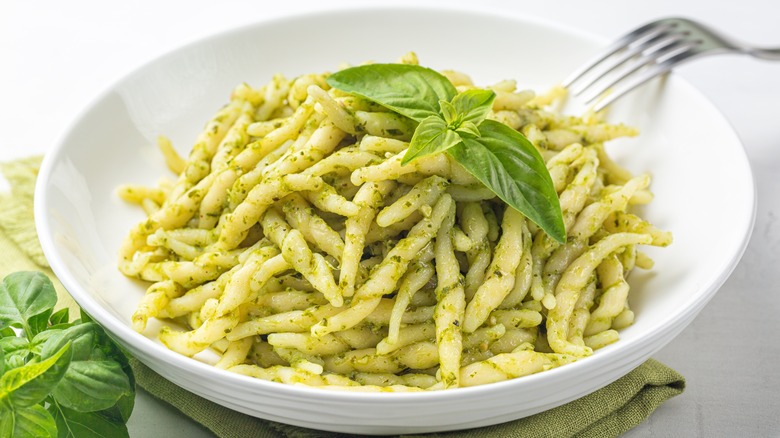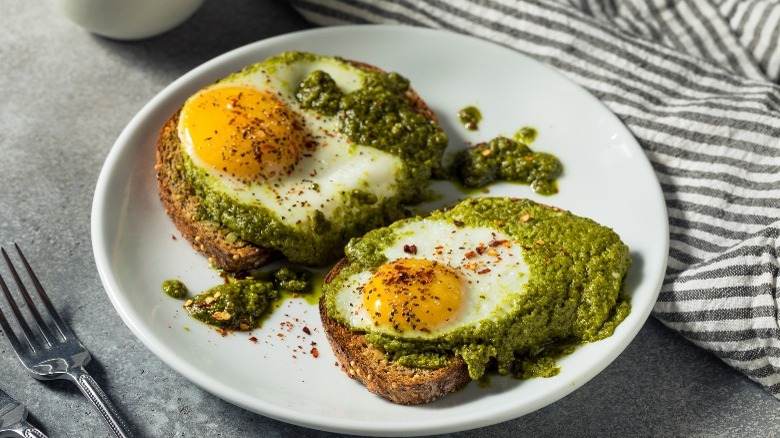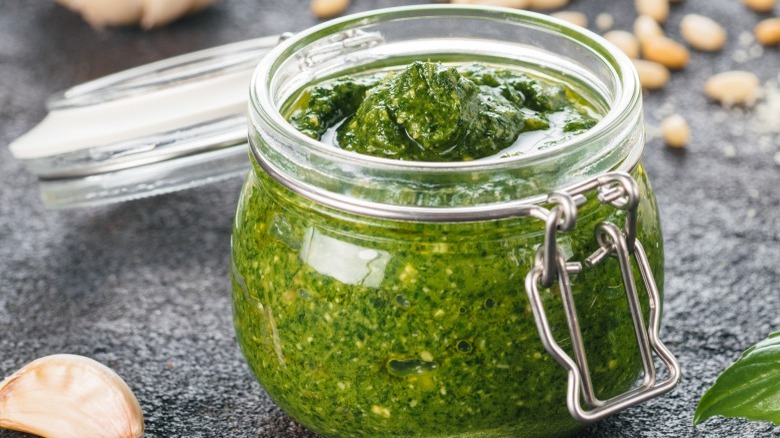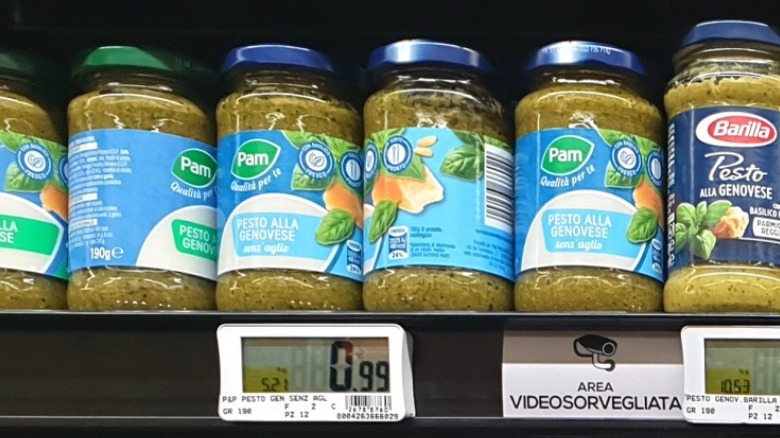Mistakes Everyone Makes When Cooking With Pesto
It's easy to see why pesto is such a popular ingredient in Italian cuisine, especially for pasta dishes. Fresh herbs offer a taste of spring, garlic adds a little pep, nuts provide some crunch, and everything is swimming in oil and cheese. Just a few basic elements provide a whole lot of love.
But while pesto's beauty may lie in its simplicity, a truly delicious pesto requires technique, restraint, and quality ingredients. There are a lot of things that can go wrong in such a straightforward process, and once you get the hang of it, a whole world beyond the traditional basil pesto alla Genovese is waiting for you to explore. If your sauce is bland and lacking in the qualities that make the combination so delicious, chances are you're committing a pesto sin.
Below are the top mistakes people tend to make when cooking with pesto (including actually cooking it). Read on to ensure you're never left with a dull mushy mess again. Go ahead, make your nonna proud.
Not putting in elbow grease
The word pesto refers not to a specific set of ingredients, but rather to a preparation method: Pestare means to pound in Italian. The ingredients are pulverized to create a coarse paste, which is then slightly emulsified with oil, according to Delicious Italy. So how do we achieve this consistency? You can use a food processor or blender, sure, but a mortar and pestle is the most traditional way. And sure enough, this method came out on top in Food52's extensive trials, beating all electric appliances and two types of knives.
The optimal mortar and pestle pesto, as explained to Food52 by the Pesto World Championship finalist Maurizio Valle, begins by crushing garlic and salt into a paste. Basil, pine nuts, and cheese follow, and finally, olive oil is stirred in with a spoon. Rather than beating the pestle against the mortar in an up-and-down motion, it's best to swirl the pestle around the rim while applying pressure, crushing the ingredients between the two. Your arm might get sore, but it's definitely worth it for the resulting smooth consistency.
Not thinking beyond basil
Basil plays a starring role in pesto alla Genovese (the green version we are most familiar with), but that doesn't mean you can't make variations with other leafy herbs. Think of what herbs pair best with the rest of your dish and go from there. A cilantro pesto might make a memorable taco condiment while lamb with mint pesto is sure to impress a date. Whichever herb (or herbs — the more the merrier) you choose, opt for softer ones rather than those with woody stems like thyme or rosemary.
You don't even have to stop at herbs. Leafy greens like arugula, spinach, or watercress can lend their own unique flavors to pesto. Heartier vegetables such as kale or chard also work, though a quick blanch and drain help soften them, preventing a gritty texture. So if you're craving pesto but basil is out of season, just turn your attention to another green.
Forgetting to toast your nuts
There are only a few ingredients in pesto, so it's essential to give each of them the VIP treatment. The best way to prepare nuts — any kind of nut and in any recipe, really — is to toast them. Toasting releases their fragrant oils according to The Kitchn, leading to a more flavorful product. Any bitterness from raw nuts transforms into a caramel-like, almost buttery quality. It goes without saying that giving nuts a toast also makes them crunchier, which helps create layers of texture in pesto.
Fortunately, it is extremely easy to toast nuts. Spread them in a single layer on a baking sheet, then pop them in an oven preheated to 350 degrees, Smitten Kitchen explains. Based on the size of the nuts you're using, toast them between five and 12 minutes, tossing them occasionally so they brown evenly. If that's too much effort, it's even possible to toast nuts in the microwave.
Sticking to one type of nut
Pine nuts (pignoli in Italian) are the standard in a pesto, but curiously enough, they're not technically nuts. They are actually the seeds (the inner part of the nut casing) of pine trees. Call them what you want, but either way, they are expensive. Fortunately, no one is stopping you from using an alternative instead.
Some substitutes for pine nuts that work particularly well in pesto include almonds, pistachios (added bonus: they're green), and walnuts. Renowned Italian chef Massimo Bottura of Modena's thrice Michelin-starred Osteria Francescana eschews the nuts altogether and opts for toasted breadcrumbs (via MasterClass).
Another reason to rethink pine nuts: the dreaded pine mouth. This is a phenomenon, the causes for which remain unknown, where the consumption of pine nuts leads to a metallic taste that can last for as long as two weeks. The FDA notes that while pine mouth doesn't appear to lead to any long-term health concerns, it will make eating any other foods significantly less pleasant for some time. Pine mouth doesn't affect everyone, but if you're nervous about your meals tasting like loose change for a while, opt for almonds.
Assuming pesto can only be green
When we think of pesto, it's typically a green herbaceous sauce. However, consider that herbs don't have to be the lead player. So long as you've got crushed ingredients, you're on your way to a pesto.
After green, the next most common variety is red pesto. In lieu of basil, this version gets its body from tomatoes (typically sun-dried) and occasionally roasted red peppers, according to Great Italian Chefs. The other ingredients remain the same: garlic, pine nuts, cheese, and oil. Trader Joe's Pesto Rosso replaces pine nuts with cashews and ups the vibrant hue and sweetness level with carrot purée.
So you've got green pesto and you've got red pesto. Why not complete the Italian flag trifecta and go for a pesto bianco, courtesy of Italy Magazine? This has some green by way of basil and marjoram but is predominantly white thanks to a generous amount of whole milk ricotta.
Picking the wrong kind of cheese
As you can tell, you can play fast and loose with some pesto ingredients — swapping basil for other herbs and leafy greens, tomatoes over herbs altogether, and any number of nuts. But you need to use a certain type of cheese to achieve pesto's familiar consistency and umami quality.
Parmesan is the golden standard in pesto, and if you're going to use it, you might as well go for the real thing: Parmigiano Reggiano (literally, from the region of Parma). Authentic Parmesan will have its name on the label and on the cheese rind. The aging process requires a minimum of 12 months according to Food & Wine, leading to a distinct nutty taste and crystalline mouthfeel.
In the absence of Parmigiano Reggiano, other hard and salty cheeses do the trick. Bon Appétit suggests Pecorino Romano, Grana Padano, and cotija, or aged varieties of manchego, Asiago, Gouda, and even basic cheddar.
Overloading on garlic
It's pretty hard to make pesto without garlic — but it's pretty easy to overdo it on the garlic. That's a fine line to balance but once you know how to navigate it, you'll be rewarded with superb pesto.
Typically, the garlic in pesto is raw and pulverized with the rest of the ingredients. Raw garlic can dominate any flavor profile very fast, punching your palate with unpleasant pungency. You want to be able to taste the garlic but you also want to savor the other ingredients, from the grassy herbs to the fruity olive oil and salty cheese. It's best to start with just a bit of garlic and go from there. Remember: You can always add more, but it's much harder to remove it later on.
If you're looking for a pesto with a bit less bite, you can tamp down the garlic flavor using a couple of different methods courtesy of SPICEography. They may not be traditional, but they work. The first is by cooking it, whether by roasting, sweating, or blanching. This will tone down the flavor by neutralizing the garlic's allinase, the enzyme that gives garlic and other alliums their kick. You can also add an acidic element like lemon juice or vinegar to the pesto to counteract the intensity of the garlic with some brightness.
Using anything but EVOO
Your pesto probably won't be awful if you use another cooking oil besides extra-virgin olive oil. However, it is the go-to for a reason as it leads to a finished product with noticeably more complexities than one made with a neutral oil like canola or even light olive oil.
Extra-virgin olive oil's manufacturing process differs from other olive oils, The Kitchn explains, in that it is not refined with chemicals or heat. This keeps the oleic acid content at a minimum (1% or less), leading to a golden-green hue and a rich, fruity taste. The absence of a refining stage also helps preserve the vitamins and minerals in the olives. This is essential if you want to take advantage of the fact that olives are a great source of Vitamin E, iron, copper, and calcium, according to Healthline.
Extra-virgin olive oil has a low smoke point, which means it will burn at relatively low temperatures and is therefore not ideal for cooking at high heat. Fortunately, pesto should not be cooked (more on that later), so EVOO is right at home in this sauce.
Not being patient when adding in the oil
Pesto is a partial emulsion, which is how it gets its silky creamy consistency without any actual cream. An emulsion, according to MasterClass, breaks down one element (here, oil) so that it can become fully dispersed throughout another (here, the pasty mixture we've made with our other ingredients). The key to doing this effectively is time.
Have you ever tried to make a vinaigrette with oil and vinegar? If you just pour one into the other and stir, they're never going to combine. But if the oil is slowly whisked in and emulsifying agents like egg yolks or mustard are at play, the mixture will become harmonious.
Think of the olive oil in pesto as a shy child. We want it to join the rest of the group, but it likes to stick to itself. So if we add it gradually, introducing more and more as it feels comfortable, everyone will be playing together before we know it. In pesto terms, this means the result will be smooth and creamy.
Putting it over heat
What makes pesto alla Genovese such a bright fresh sauce is the fact that it is made using raw ingredients. And when serving it, it's best to keep those ingredients in this state. Serious Eats explains that pesto goes against the typical pasta preparing process in which a sauce is warmed in a pan before the pasta is added (usually with some of the starchy pasta water). If we did that to pesto, we would end up cooking those delicate basil leaves, diluting the flavor and diminishing its verdancy.
Instead, the best time to incorporate pesto into pasta is at the very end, once the pasta's consistency has reached al dente. Transfer the pasta to a large bowl, add the pesto, and mix vigorously. Ladle in a bit of the pasta water; it'll warm up the sauce without cooking it and help achieve the saucy consistency we're looking for.
Serving it with the wrong type of pasta
Italians have particular rules to follow when it comes to pasta. Always salt your pasta water. Strive for al dente. And never, ever break your spaghetti. Additional rules deal with pairing sauces with specific pasta shapes. These guidelines aren't just there so that Italians can yell at you when you disobey them. In fact, the reasoning behind coordinating types of pasta with sauces makes sense.
For instance, pesto is typically paired with pasta attorcigliata, aka twisted pasta. Examples, according to Eataly, include fusilli, trofie, and caserecce. These shapes have plenty of nooks and crannies, which are the perfect places for pesto's pulverized bits to cling to. Another common pesto companion is trenette, a long, noodle variety akin to linguine. This duo is a local favorite in the region of Liguria, where it is paired with green beans and potatoes that cook in the pasta water (per La Cucina Italiana).
Only using pesto with pasta
There's no denying it: Pesto is great with pasta — provided you use the right pasta shape. But pasta is only the start of pesto's capabilities. The stuff can elevate all sorts of dishes and ingredients, providing an earthy herbal kick to your plate. Pesto may be a pasta staple, but it's equally at home marinating a piece of chicken or spooned atop a sliced sirloin.
The sauce can also act as a flavor enhancement to condiments and dips. Stir some into hummus for an Italian twist on the traditional mezze or spruce up your next crudité platter with pesto ranch. How about trying a two-ingredient pesto aioli (pesto and mayonnaise) as a creamy sandwich spread? Don't leave breakfast out of the fun — boost your bagel with pesto cream cheese.
You can also think of pesto as a finishing oil; one of its key components is extra-virgin olive oil, after all. Stir a bit into a bowl of soup just before serving, as Cook Smarts suggests, whisk some into a vinaigrette, or drizzle a bit onto a pizza.
Not storing it properly
Pesto — with its fresh ingredients and cheese — is perishable, so you need to keep it refrigerated if you plan on storing it for extended periods. Even shelf-stable varieties will need to be refrigerated once opened, so don't throw them back into the pantry.
Additionally, basil will oxidize if exposed to air (even in the fridge), and this will cause it to lose its vibrancy. You want pesto to stay green, not turn brown. An easy way to prevent this is by pouring a thin layer of olive oil over the sauce's surface. The oil will act as a natural seal, blocking any air from reaching it. And olive oil is already an ingredient in pesto, so when you are ready to use it just give it a stir and you're good to go.
If you're hoping to store pesto for longer than a few days, most varieties will freeze just fine if kept in an airtight container. Oh Sweet Basil suggests placing individual portions of pesto in ice cube trays, then transferring the frozen blocks to a freezer bag. This will allow you to grab and defrost single servings at any time. Because you deserve some pesto all to yourself.
Insisting on making it yourself every time
Pesto is besto and fresh is best. With that said, we have to admit that sometimes, it's worth saving time and opting for store-bought. Making pesto from scratch is a labor of love, and if the sauce is going to be the main attraction of your plate (say, in a pasta course), you should definitely make the effort. But having ready-made pesto on hand is a great way to amp up any meal without the arm workout or having to whip out the food processor.
When looking for pesto in the grocery store, you've got options. Jarred pestos range in quality, and the additives that are used to make them shelf-stable can risk the quality of the flavor. You're better off heading to the refrigerated section where you're likely to find a tub of pesto next to the ricotta and fresh pasta. It may also be close to fresh herbs with the produce, according to Infogrocery. These pestos typically have fewer preservatives so they won't last as long as jarred varieties, but they do help to cut back on the prep time.
We won't tell your nonna. We promise.
